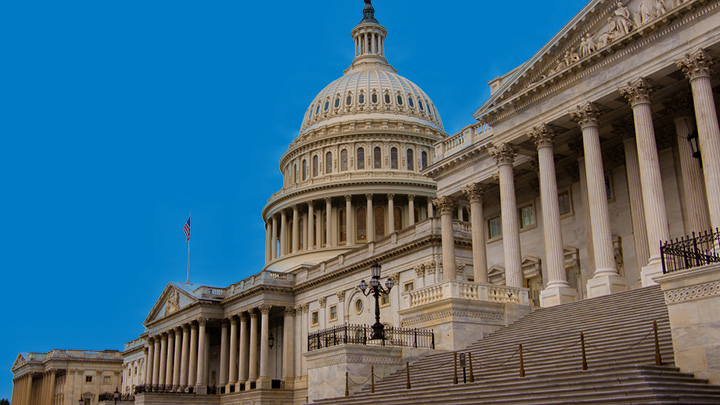Pity the Federal Reserve (Fed) and its data-dependent mantra. Although participants can make some general assumptions about economic conditions—inflation remains above its target and isn’t falling while cracks continue to appear in the labor market—investors and the Fed are now starved for data on both sides of its mandate thanks to the partial shutdown of the federal government. In an environment where the Fed is under heightened scrutiny and investors remain fixated on each policy-related nuance, what are investors to do?
One place that we’ve recently returned to is a model that aims to measure the economy’s “exhaust,” or the information emitted in the normal course of daily life. Although this information was not meant to be an economic statistic per se, it can provide pertinent and timely economic signals. To that end, we’ve applied natural language processing (NLP) techniques to large volumes of media text to measure how much attention “unemployment” and “inflation” receive. With that in mind, let’s look at the Fed’s mandate and show how this modern dataset can shed some light on what has become a data void.
As early as the 1940s, policymakers debated how monetary policy should support broader economic goals, with the emphasis shifting over time between employment and inflation control. These debates have consistently acknowledged the inherent tensions in pursuing multiple goals, especially when the objectives conflict. The current economic backdrop puts the Fed in a difficult position: tightening monetary policy to curb inflation poses risks to the job market, while policy easing to support jobs may exacerbate inflationary pressures. Figure 1 shows how U.S. unemployment and inflation have evolved recently.
Figure 1: Unemployment Low, but Trending Higher, While Inflation Remains Uncomfortably Above Target
In the context of this tension amidst a data void, our suite of supervised NLP-based indicators dynamically extracts topics from a wide range of high-quality news sources.1 Unlike traditional NLP analyses that focus on sentiment, our models aim to quantify the attention paid to a particular topic over time.
The methodology employs the transformer architecture, which captures complex relationships between words by representing them as dense numerical vectors, and uses attention mechanisms to assign context-dependent weights to different words in a sequence.2 Leveraging this capability, we scan thousands of articles daily to extract underlying semantic topics.
Figure 2: Prominence in News Flow: Unemployment and Inflation
The scatter plot in Figure 2 shows the attentiveness scores for both unemployment and inflation from our in-house NLP models.3 Higher scores reflect greater prominence of the topic in publicly available news sources.
It’s evident that from July to September 2025, attention to both topics intensified, with unemployment drawing relatively more focus than inflation. One plausible explanation is that the recent uptick in inflation may be transitory, driven by one-off price effects such as tariff-related increases, rather than persistent pressures. Since the U.S. government shutdown at the beginning of October, while attention scores are less elevated than in September, they remain relatively prominent for both unemployment and inflation. Furthermore, the attention score to unemployment observed in the early October data is among the highest since 2000.
We also note how the attention to unemployment and inflation evolved in earlier periods. As the unemployment rate rose in 2024 from 3.9% in April to 4.2% in July, attention shifted to unemployment over inflation. In contrast, the highest attention scores for inflation appeared in the post-COVID summer of 2022, coinciding with a period when both Core CPI and Core PCE were elevated in the 5%-6.6% range.
In an era where partial shutdowns of the U.S. government are increasingly frequent occurrences, investors are left to scour for alternative data sources. Our NLP-based attentiveness scores offer a timely read on which side of the dual mandate is commanding the conversation, providing context around expectations for market pricing and/or potential policy adjustments.
1 Articles supplied via Bloomberg Professional Services; underlying sources include Bloomberg News, The New York Times, other major newspapers, and select web scrapes. https://www.bloomberg.com/professional
2 Vaswani et al. (2017). “Attention Is All You Need.” https://proceedings.neurips.cc/paper_files/paper/2017/file/3f5ee243547dee91fbd053c1c4a845aa-Paper.pdf
3 Each point represents the monthly average of daily scores; coverage spans Jan 2000–Sep 2025. (Internal calculation and methodology to be detailed in forthcoming paper.)
This material is intended for Professional Investors only. All investments involve risk, including the possible loss of capital. Past performance is not a guarantee or a reliable indicator of future results.
PGIM Quantitative Solutions LLC (PGIM Quantitative Solutions or PGIM Quant) is an SEC-registered investment adviser and a wholly-owned subsidiary of PGIM, Inc. (PGIM) the principal asset management business of Prudential Financial, Inc. (PFI) of the United States of America. Registration with the SEC does not imply a certain level of skill or training. PFI of the United States is not affiliated in any manner with Prudential plc, which is headquartered in the United Kingdom or with Prudential Assurance Company, a subsidiary of M&G plc, incorporated in the United Kingdom.
The comments, opinions and estimates contained herein are based on and/or derived from publicly available information from sources that PGIM Quantitative Solutions believes to be reliable. We do not guarantee the accuracy of such sources of information and have no obligation to provide updates or changes to these materials. This material is for informational purposes and sets forth our views as of the date of this presentation. The underlying assumptions and our views are subject to change.
These materials are neither intended as investment advice nor an offer or solicitation with respect to the purchase or sale of any security or financial instrument. These materials are not intended to be an offer with respect to the provision of investment management services. The opinions expressed herein do not take into account individual client circumstances, objectives, or needs and are therefore not intended to serve as investment recommendations. No determination has been made regarding the suitability of particular strategies to particular clients or prospects. The financial indices referenced herein is provided for informational purposes only. You cannot invest directly in an index. The statistical data regarding such indices has been obtained from sources believed to be reliable but has not been independently verified.
Certain information contained herein may constitute “forward-looking statements,” (including observations about markets and industry and regulatory trends as of the original date of this document). Due to various risks and uncertainties, actual events or results may differ materially from those reflected or contemplated in such forward-looking statements. As a result, you should not rely on such forward-looking statements in making any decisions. No representation or warranty is made as to future performance or such forward-looking statements.
In the United Kingdom, information is issued by PGIM Limited with registered office: Grand Buildings, 1-3 Strand, Trafalgar Square, London, WC2N 5HR. PGIM Limited is authorised and regulated by the Financial Conduct Authority (“FCA”) of the United Kingdom (Firm Reference Number 193418). In the European Economic Area (“EEA”), information may be issued by PGIM Investments (Ireland) Limited, PGIM Netherlands B.V. or PGIM Limited depending on the jurisdiction. PGIM Investments (Ireland) Limited, with registered office: 2nd Floor, 5 Earlsfort Terrace, Dublin 2, Ireland. PGIM Investments (Ireland) Limited is authorised and regulated by the Central Bank of Ireland (Reference No. C470709) and operates on the basis of a European passport. PGIM Netherlands B.V., with registered office at Eduard van Beinumstraat 6, 1077CZ, Amsterdam, The Netherlands, is authorised by the Autoriteit Financiële Markten (“AFM”) in the Netherlands (Registration number 15003620) and operates on the basis of a European passport. In certain EEA countries, information is, where permitted, presented by PGIM Limited in reliance on provisions, exemptions or licenses available to PGIM Limited under temporary permission arrangements following the exit of the United Kingdom from the European Union.
In Australia, this document is provided to prospective investors and, by receiving it, each prospective investor is deemed to represent and warrant that it is a “Wholesale Client” (as those terms are defined in Australian Corporations Act 2001 (Cth) (Act)). PGIM Quantitative Solutions LLC is exempt from the requirement to hold an Australian financial services license under the Act (as a result of the operation of Class Order Exemption 03/1100) in respect of the financial services it provides to Wholesale Clients in Australia and is regulated by the SEC which differ from Australian laws.
In Switzerland, information is issued by PGIM Limited, through its Representative Office in Zurich with registered office: Limmatquai 4, 8001 Zürich, Switzerland. PGIM Limited, Representative Office in Zurich is authorised and regulated by the Swiss Financial Market Supervisory Authority FINMA and these materials are issued to persons who are professional or institutional clients within the meaning of Art.4 para 3 and 4 FinSA in Switzerland.
In Canada, PGIM Quantitative Solutions LLC relies upon the “International Advisor Exemption” pursuant to National Instrument 31-103 in certain provinces of Canada.
In Singapore, information is issued by PGIM (Singapore) Pte. Ltd. (“PGIM Singapore”), a regulated entity with the Monetary Authority of Singapore under a Capital Markets Services License to conduct fund management and an exempt financial adviser. This material is issued by PGIM Singapore for the general information of “institutional investors” pursuant to Section 304 of the Securities and Futures Act 2001 of Singapore (the “SFA”) and “accredited investors” and other relevant persons in accordance with the conditions specified in Section 305 of the SFA.
In Hong Kong, information is provided by PGIM (Hong Kong) Limited, a regulated entity with the Securities & Futures Commission in Hong Kong to professional investors as defined in Section 1 of Part 1 of Schedule 1 of the Securities and Futures Ordinance (Cap.571).
In Japan, the investment management capabilities and services described in the attached materials are offered by PGIM Japan Co., Ltd (PGIMJ), a Japanese registered investment adviser (Director-General of the Kanto Local Finance Bureau (FIBO) No. 392). Retention of PGIMJ for the actual provision of such investment advisory services may only be affected pursuant to the terms of an investment management contract executed directly between PGIMJ and the party desiring such services, it is anticipated that PGIMJ would delegate certain investment management services to its US-registered investment advisory affiliate.
In Korea, PGIM Quantitative Solutions LLC holds cross-border discretionary investment management and investment advisory licenses under the Korea Financial Investment Services and Capital Markets Act (“FSCMA”), and is registered in such capacities with the Financial Services Commission of Korea. These materials are intended solely for Qualified Professional Investors as defined under the FSCMA and should not be given or shown to any other persons.
These materials are not intended for distribution to, or use by, any person in any jurisdiction where such distribution would be contrary to local or international law or regulation. The views and opinions herein do not take into account individual client circumstances, objectives, or needs and are not intended as recommendations of particular securities, financial instruments or strategies to particular clients or prospects. No determination has been made regarding the appropriateness of any securities, financial instruments or strategies for particular clients or prospects. For any securities or financial instruments mentioned herein, the recipient(s) of this report must make its own independent decisions.
Foreign investments may be volatile and involve additional expenses and special risks, including currency fluctuations, foreign taxes and political and economic uncertainties. Emerging and developing market investments may be especially volatile. Investments in securities of growth companies may be especially volatile. Due to the recent global economic crisis that caused financial difficulties for many European Union countries, Eurozone investments may be subject to volatility and liquidity issues. Value investing involves the risk that undervalued securities may not appreciate as anticipated. Small and mid-sized company stock is typically more volatile than that of larger, more established businesses, as these stocks tend to be more sensitive to changes in earnings expectations and tend to have lower trading volumes than large-cap securities, creating potential for more erratic price movements. It may take a substantial period of time to realize a gain on an investment in a small or mid-sized company, if any gain is realized at all. Diversification does not guarantee profit or protect against loss. Emerging markets are countries that are beginning to emerge with increased consumer potential driven by rapid industrial expansion and economic growth. Investing in emerging markets is very risky due to the additional political, economic and currency risks associated with these underdeveloped geographic areas. Fixed-income investments are subject to interest rate risk, and their value will decline as interest rates rise. Unlike other investment vehicles, U.S. government securities and U.S. Treasury bills are backed by the full faith and credit of the U.S. government, are less volatile than equity investments, and provide a guaranteed return of principal at maturity. Treasury Inflation-Protected Securities (TIPS) are inflation-index bonds that may experience greater losses than other fixed income securities with similar durations and are more likely to cause fluctuations in a Portfolio’s income distribution. Investing in real estate poses risks related to an individual property, credit risk and interest rate fluctuations. High yield bonds, commonly known as junk bonds, are subject to a high level of credit and market risks. Investing involves risks. Some investments are riskier than others. The investment return and principal value will fluctuate and when sold may be worth more or less than the original cost.
PGIM Quantitative Solutions affiliates may develop and publish research that is independent of, and different than, the views and opinions contained herein. PGIM Quantitative Solutions personnel other than the author(s), such as sales, marketing and trading personnel, may provide oral or written market commentary or ideas to PGIM Quantitative Solutions’ clients or prospects or proprietary investment ideas that differ from the views expressed herein. Additional information regarding actual and potential conflicts of interest is available in PGIM Quantitative Solutions’ Form ADV Part 2A. Asset allocation is a method of diversification that positions assets among major investment categories. Asset allocation can be used to manage investment risk and potentially enhance returns. However, use of asset allocation does not guarantee a profit or protect against a loss.
© 2025 PGIM Quantitative Solutions. All rights reserved. PGIM, PGIM Quantitative Solutions, the PGIM Quantitative Solutions logo and the Rock design are service marks of PFI and its related entities, registered in many jurisdictions worldwide.
Collapse Section


)

